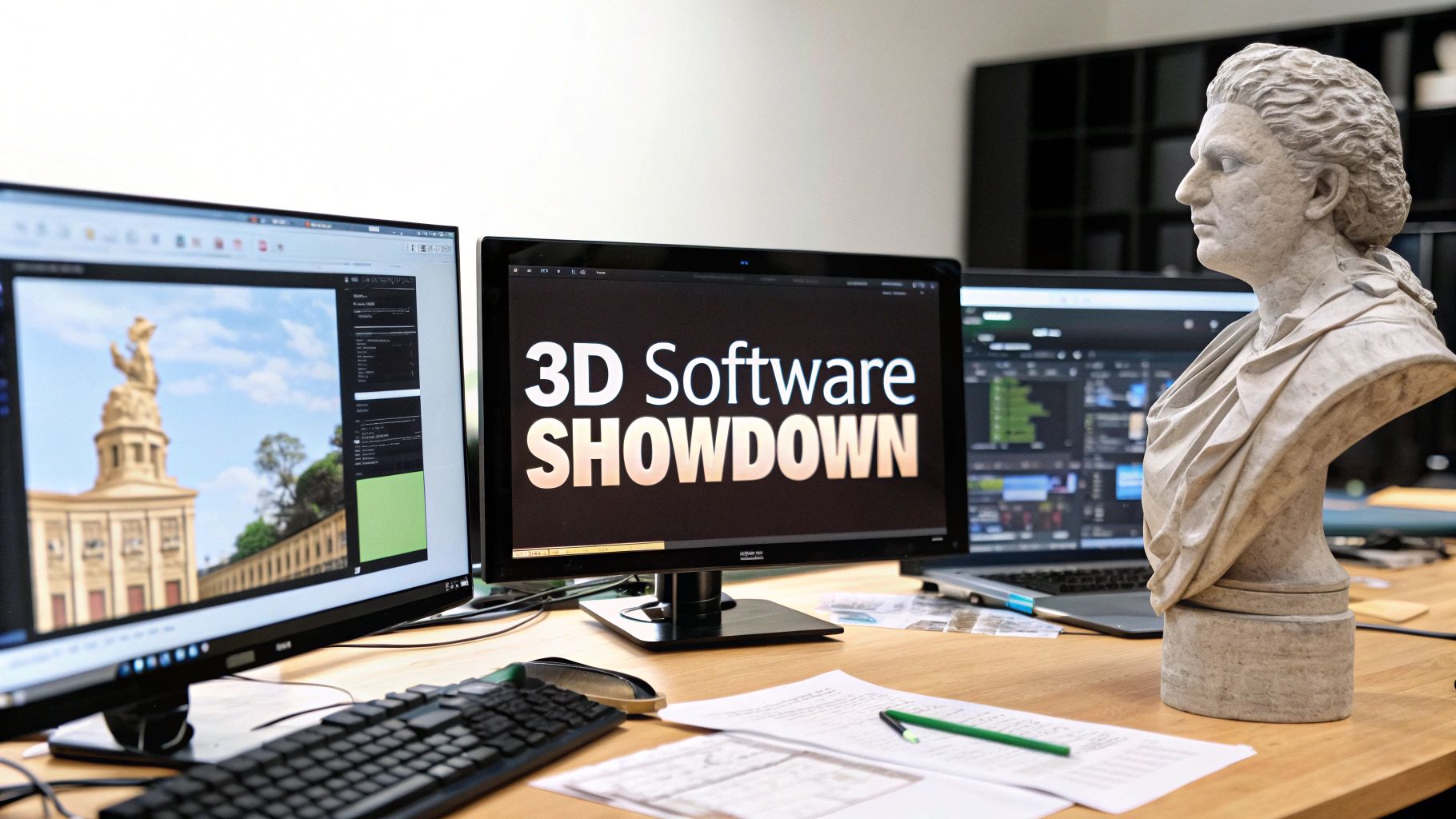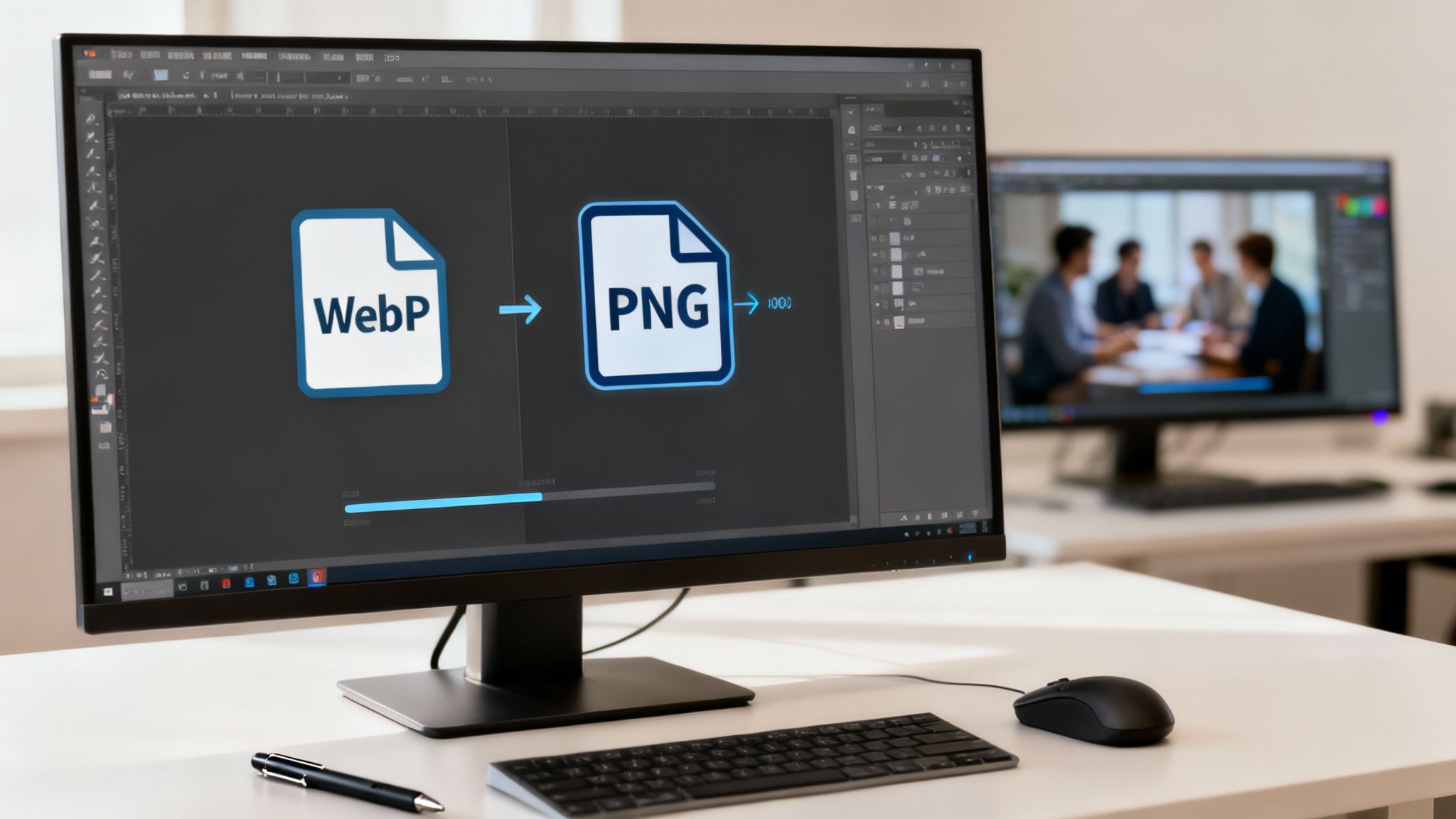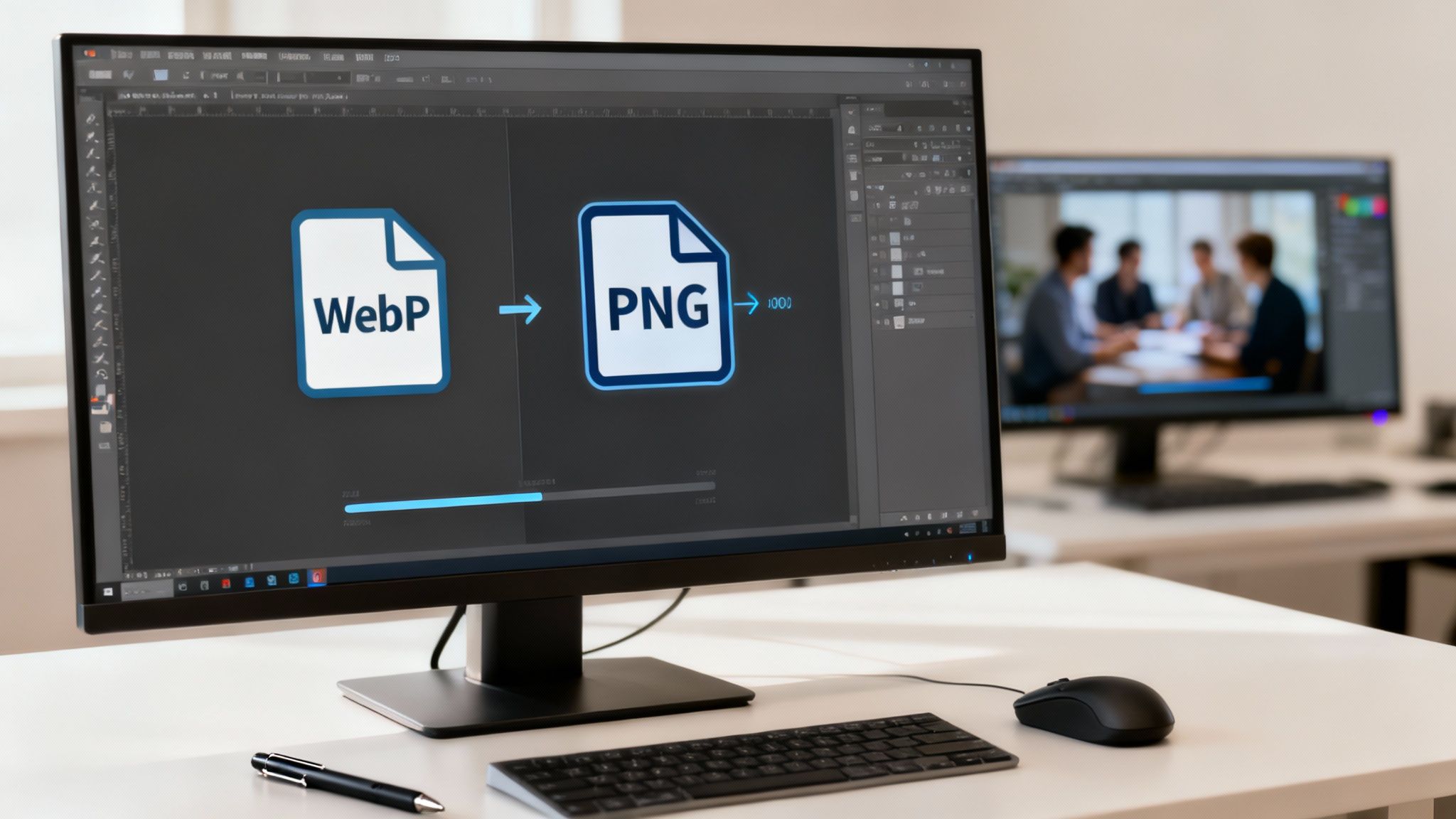Selecting the right 3D modeling software is a strategic business decision that impacts your team's entire operational workflow. For enterprise creative teams, a thorough software comparison must extend beyond feature sets to evaluate critical factors like security, compliance, and scalability. This guide provides a detailed analysis of leading software solutions to help you make an informed choice that is not only creatively effective but also aligns with corporate governance and security standards.
How to Choose Your Team's 3D Modeling Software
The objective is not to identify a single "best" tool, but to select the software that aligns with your team's specific operational requirements and business objectives. The chosen platform becomes a central component of your creative process, governing the workflow from initial concept to final render. It fundamentally shapes asset quality and determines how effectively your team can collaborate, particularly within distributed or remote environments.
For any enterprise, the evaluation criteria must include data security, software compliance, and the total cost of ownership. A tool may offer an advanced feature set, but if it introduces security vulnerabilities or fails to integrate with existing pipelines, it represents a significant operational risk and potential for workflow disruption.
Key Contenders for Enterprise Teams
This analysis will provide a detailed comparison of industry-standard software, each offering distinct advantages for professional teams:
- Virtuall: An AI-powered workspace engineered for secure, collaborative 3D asset creation and management, designed specifically for enterprise creative teams.
- Blender: A powerful open-source solution known for its extensive flexibility and large support community.
- 3ds Max & Maya: Autodesk's industry-standard applications, which are leaders in architectural visualization and character animation, respectively.
- Cinema 4D: A leading choice for motion graphics and visual effects, widely recognized for its user-friendly and efficient interface.
By evaluating these tools through an enterprise framework, we can move beyond marketing claims to identify the solution that best supports a secure, productive, and compliant creative workflow.
The table below offers a high-level summary of our contenders, serving as a preliminary reference before we delve into more detailed analysis.
Diving Deeper: Performance, Integration, and Collaboration
A meaningful 3d modeling software comparison for professional teams must assess how a tool performs under operational pressure and integrates into existing creative pipelines. The evaluation should focus on the software's ability to handle complex tasks that directly impact project deadlines and deliverables.
Rendering speed and real-time viewport performance are primary considerations. Slow rendering processes can create significant project bottlenecks, delaying feedback cycles and extending timelines. Similarly, a poorly performing viewport can impede creativity, particularly when working with complex scenes or high-polygon models. The details of choosing software for image rendering are critical to operational efficiency.
Does It Play Well with Others?
Performance is only one part of the equation; compatibility is equally important. Enterprise creative teams rarely operate within a single-software environment. Your 3D tool must interface seamlessly with a suite of other applications for tasks such as texture creation, animation, and final compositing.
Therefore, key integration questions include:
- Does it support industry-standard file formats without data loss or interoperability issues?
- Does it provide a stable API or scripting environment for automating repetitive workflow tasks?
- Can it integrate with your Digital Asset Management (DAM) system to ensure robust version control?
The answers to these questions will determine whether a new tool will enhance or disrupt your existing ecosystem.
The optimal software solution is one that enhances the entire creative ecosystem, not just a single function. A truly enterprise-ready platform integrates seamlessly, adheres to security protocols, and improves overall team productivity.
Collaboration and the AI Boost
In the context of modern remote and hybrid work models, integrated collaboration tools are a business necessity. Built-in systems for review and feedback, a clear version history, and granular user permissions are essential for maintaining project oversight and ensuring that only authorized personnel can approve significant changes. To learn more about how modern teams manage these processes, review our guide on creative operations for 3D content at scale.
This requirement for more integrated and intelligent tools is a primary driver of market growth. The global 3D design software market was valued at approximately $8.95 billion in 2021 and is projected to reach $11.46 billion by 2025. North America represents a significant portion of this market, holding a 34.69% share, driven by enterprise demand for sophisticated creative solutions.
Finally, the role of AI must be considered. AI-driven features that automate texturing, generate model variations, or optimize assets are becoming critical for meeting demanding production schedules. A prudent evaluation assesses how a platform leverages AI not as a novelty, but as a practical and secure tool to demonstrably accelerate your team's workflow.
A Detailed Comparison of Professional 3D Software
Selecting the right 3D software for your team requires a thorough analysis of how these tools perform in daily operations. For enterprise creative teams, the decision extends beyond a feature list to how a platform’s core modeling methodology aligns with specific project types, from architectural visualization to complex character animation. A tool that excels in one domain may create bottlenecks in another.
Let's conduct a detailed examination of Virtuall, Blender, 3ds Max, Maya, and Cinema 4D, focusing on criteria that are paramount for professional teams: productivity, security, and final output quality.
Modeling Paradigms and Workflow Efficiency
The fundamental approach to model creation differs significantly across these platforms. Blender, as an open-source solution, provides extensive flexibility with a comprehensive toolkit for polygonal, sculpting, and procedural modeling. This positions it as an effective all-in-one solution for teams with diverse project needs. However, this flexibility is accompanied by a steep learning curve that often necessitates dedicated training and support.
Conversely, Autodesk’s offerings—3ds Max and Maya—are highly specialized. 3ds Max is recognized for its powerful polygonal modeling and modifier stack, making it highly efficient for architectural and hard-surface modeling. Maya’s strengths lie in character rigging, animation, and NURBS modeling, solidifying its position as the standard in the film and game animation industries. For specialized teams, selecting the appropriate Autodesk tool is a critical operational decision.
Virtuall introduces a different paradigm. Instead of requiring artists to build from scratch, its AI-driven approach generates high-quality base models from text or image inputs. This fundamentally alters the workflow, significantly reducing initial modeling time and allowing creative teams to focus on refinement and detail. For businesses requiring rapid content production, this represents a substantial efficiency gain.
This chart provides a data-driven perspective on how some of the most popular tools compare on key performance metrics.
As illustrated, some tools prioritize rendering speed while others offer broader compatibility. The key is to identify which trade-offs are acceptable for your team's specific operational needs.
Use Case Suitability and Specialization
Aligning software capabilities with job requirements is crucial. A direct comparison highlights the degree of specialization among these tools.
- Cinema 4D is a leader in motion graphics. Its intuitive interface and strong integration with Adobe After Effects make it the standard for broadcast and advertising agencies that must produce complex animations under tight deadlines.
- Blender’s versatile nature makes it a suitable choice for small to mid-sized studios that require a powerful solution without significant licensing costs. Its large community also offers a vast repository of free plugins and educational resources.
- Virtuall is purpose-built for corporate creative teams where secure collaboration and asset management are non-negotiable. With integrated Kanban boards and AI generation, it is designed for workflows where speed, consistency, and rigorous project oversight are paramount.
3D Modeling Software Feature and Workflow Comparison
To further clarify the distinctions, the following table breaks down how each platform addresses key aspects of the professional 3D workflow. This comparison focuses on the core strategic focus of each tool rather than an exhaustive feature list.
This overview helps frame the decision-making process around not just what a tool can do, but what it is optimized to do.
For teams new to 3D, establishing a strong foundational understanding is important. Our guide on the best 3D modeling software for beginners provides a solid starting point. Adopting a structured evaluation methodology is key—a practice seen in other technology sectors, as detailed in a comprehensive software comparison guide. Ultimately, the right tool is one that aligns with your team's workflow, security requirements, and long-term business objectives.
How AI and Automation Are Shaping 3D Workflows
Artificial intelligence is no longer a future concept in 3D design; it is a practical technology that is actively transforming professional workflows. For enterprise teams, the value of AI is measured not by its novelty but by its ability to deliver tangible efficiency gains within a secure and controlled creative environment.
Any modern 3d modeling software comparison must evaluate how these tools apply AI to solve real-world business problems.
The most significant impact of AI is in automation. It excels at managing time-consuming, repetitive tasks that would otherwise occupy skilled artists, allowing them to focus on high-value creative work. Processes such as initial concept generation or the texturing of complex models can be reduced from hours to minutes.
Comparing Practical AI Implementations
The application of AI varies significantly between platforms, typically tailored to their core functionalities. For a business, understanding these differences is crucial for making a sound—and compliant—investment.
- Virtuall’s Proprietary AI: Virtuall integrates AI directly into its core platform, offering tools for automated texturing and text-to-3D model generation. This system is engineered for secure, high-volume content creation, enabling teams to produce consistent, high-quality assets rapidly within a managed, collaborative environment.
- Blender’s AI Ecosystem: As an open-source platform, Blender relies on community-developed AI add-ons. Its AI-powered denoiser is effective for accelerating renders, and plugins like Dream Textures enable generative texturing. However, reliance on third-party plugins can introduce security and support challenges for enterprise teams.
- Generative Modeling Plugins: Major platforms like 3ds Max and Maya are also incorporating AI through native features and third-party plugins. These tools are often highly specialized for tasks like retopology or procedural modeling, providing powerful but sometimes fragmented solutions.
The key differentiator for businesses is not simply whether a platform incorporates AI, but how it is integrated. A tool with built-in, secure AI features offers a more reliable and manageable solution than one dependent on a patchwork of external plugins that may pose compliance risks.
The Strategic Advantage of Integrated AI
For teams producing content at scale, a fully integrated AI workflow offers a significant strategic advantage. It ensures that every asset created adheres to project standards and is managed within a secure system from its inception. This approach mitigates the risks associated with using unvetted tools and streamlines the entire production pipeline.
The dialogue surrounding AI is evolving rapidly, and understanding its direct impact on design is essential. To explore this topic further, you can learn more about how generative AI is changing the future of 3D design in our detailed article.
Ultimately, the software that provides the most practical, secure, and seamlessly integrated AI will be the one that enables your team to operate more efficiently and effectively—without compromising on security or quality.
Matching Software to Your Industry Use Case
It is important to state that there is no single "best" 3D modeling software. The optimal tool is the one that aligns with your team's specific functional requirements. The needs of an architectural firm drafting precise blueprints are fundamentally different from those of a VFX studio developing character animations.
Making the correct choice has a direct impact on business outcomes. It influences project timelines, budgets, and the final quality of deliverable assets.
Architecture and Product Design
In industries where dimensional accuracy is paramount, precision is the primary requirement. This is the domain where tools like Autodesk's 3ds Max have traditionally excelled. Its robust polygonal modeling tools and extensive modifier stack are designed for creating dimensionally accurate architectural visualizations and product prototypes.
However, this level of technical depth can create bottlenecks. For corporate teams that need to visualize product concepts quickly for marketing or internal reviews, a more agile solution may be more appropriate. A platform like Virtuall is well-suited for this, using AI to generate concepts rapidly within a secure environment designed to protect proprietary designs.
Film Animation and VFX
In film and high-end visual effects, the focus is on creating believable character animation. Maya is the recognized industry standard in this area. Its toolsets for rigging, skinning, and animation are unparalleled for producing expressive, life-like characters. It is a deep, complex platform designed for specialists with dedicated expertise.
The key differentiator is workflow specialization. While Maya is engineered for intricate character work, a tool like Cinema 4D is often preferred for motion graphics due to its intuitive interface, making it ideal for the fast-paced demands of broadcast and advertising.
Game Development
Game development requires a careful balance between artistic quality and real-time performance optimization. This is why Blender has gained significant traction with independent and mid-sized studios. It is a cost-effective (free) and versatile solution with a toolkit that supports the entire pipeline, from modeling and sculpting to texturing and animation.
Its open-source nature allows teams to customize it to build proprietary pipelines—a significant advantage. This demand contributes to the 3D modeling market's projected growth from $7.93 billion in 2025 to $22.19 billion by 2032, at a CAGR of 16.5%. You can explore these market trends and projections on Fortune Business Insights.
The Cross-Disciplinary Corporate Solution
For large enterprises with diverse creative needs across multiple departments, a different solution is required. Marketing, R&D, and training teams all have distinct requirements but must collaborate securely.
Virtuall was developed for this specific use case. It functions as a central, compliant hub where different departments can collaborate on 3D assets without compromising security. With AI-powered generation and streamlined asset management, it provides the speed, consistency, and oversight that modern corporate workflows require.
Making the Right Call for Your Enterprise
Having reviewed the side-by-side comparisons, it is time to consider the broader business context. The final decision should not be based solely on which tool has the most features, but on which one aligns with your long-term business strategy. For an enterprise, this means prioritizing security, scalability, and the total cost of ownership.
Each platform analyzed has a specific area of strength. Maya remains a leader in animation, and Blender’s open-source flexibility is advantageous for certain teams. However, your decision must support your company's broader objectives.
For teams that must prioritize security and seamless cross-departmental collaboration, a managed ecosystem like Virtuall is designed for corporate oversight. It is engineered from the ground up to be a secure, central hub for creating and managing assets, ensuring that your creative workflows are both efficient and compliant.
An enterprise-ready tool is more than a creative suite; it’s a secure asset that scales with your business, protects intellectual property, and provides reliable support when you need it most.
This forward-looking perspective is crucial. The global 3D model design software market was valued at USD 3.4 billion in 2025 and is projected to grow rapidly, driven by demand in manufacturing and AR/VR. More details on this expanding market and its key drivers are available. To add more structure to your selection process, exploring various decision-making frameworks can help clarify the optimal path forward.
A Few Final Questions
Before concluding this 3d modeling software comparison, let's address a few common questions that arise when teams evaluate a new creative tool.
How Long Will It Take My Team to Learn It?
This is a significant consideration. The learning curve varies substantially between tools. A complex platform like Blender or Maya is extremely powerful, but achieving team proficiency requires a considerable time investment and likely formal training.
Conversely, some platforms are designed to be intuitive, enabling teams to become productive more quickly. In a fast-paced business environment, minimizing onboarding disruption is a key objective. A tool with intelligent AI features can further reduce this ramp-up time by automating complex tasks.
Can We Actually Integrate This into Our Existing Pipeline?
A new tool is of little value if it cannot integrate with your current operational setup. The baseline requirement is compatibility—your new software must support standard file formats such as FBX, OBJ, and USD without causing data corruption or workflow friction.
Beyond that, look for robust API support. A well-documented API allows for the development of custom scripts and automations, which is critical for integrating the new tool with your existing asset management systems and workflows.
Do not overlook security. Any new software must align with your company's security protocols. A tool that integrates smoothly without introducing compliance vulnerabilities is a much more prudent and secure long-term investment.
How Do We Future-Proof This Decision?
You want to avoid repeating this extensive evaluation process in the near future. Future-proofing your decision involves selecting a platform with a clear commitment to innovation, particularly in the areas of AI and real-time collaboration.
Review the provider's update history and product roadmap. A forward-thinking developer ensures that your team will not be left with obsolete technology, helping you remain competitive without the constant disruption of adopting new software.
Ready to see how a platform that's AI-powered, secure, and built for collaboration can transform your creative workflow? Explore Virtuall to discover a more intelligent approach to 3D content management. Find out more at https://virtuall.pro.











